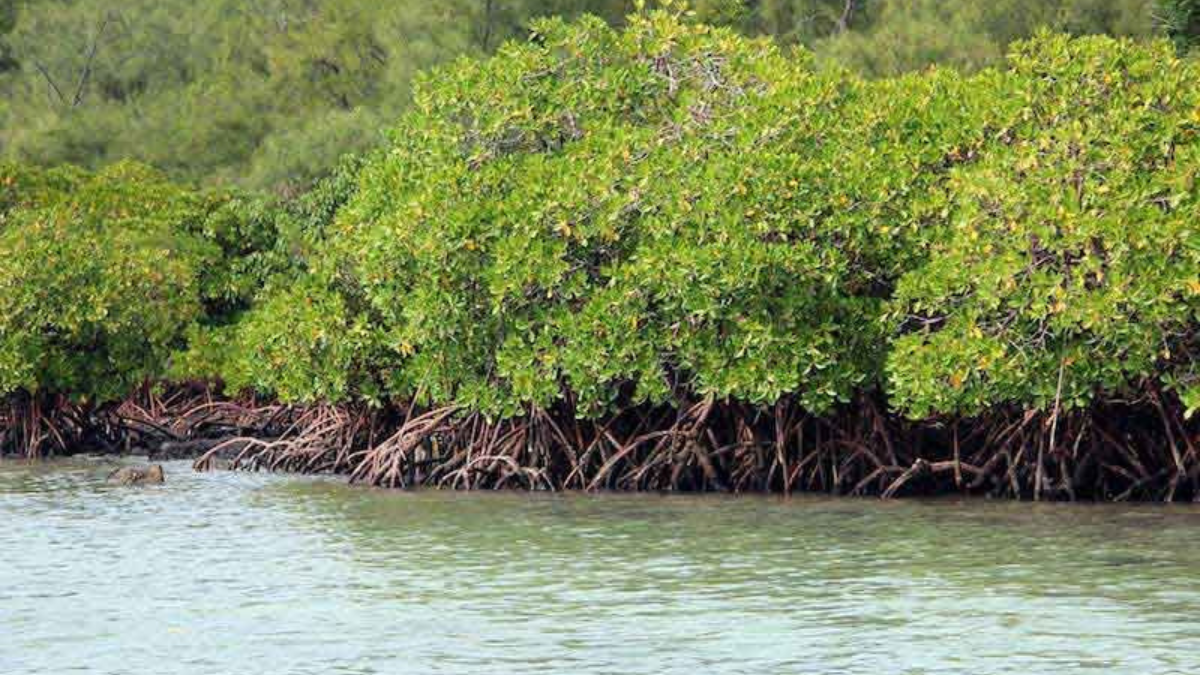A groundbreaking report titled “Blue Carbon and its Role in Carbon Sequestration”, published in 2024, has revealed the immense potential of mangroves in combating climate change. The report highlights that mangroves alone can store more than 1,000 tons of carbon per hectare, making them one of the most effective natural carbon sinks. This discovery underscores the critical importance of blue carbon ecosystems in global efforts to mitigate climate change and achieve sustainability goals.
What is Blue Carbon?
Definition and Scope
Blue carbon refers to the carbon captured and stored by the world’s ocean and coastal ecosystems. These ecosystems include mangroves, seagrass meadows, salt marshes, and tidal swamps. Unlike terrestrial forests, these coastal ecosystems are exceptionally efficient at sequestering and storing carbon, making them vital in the fight against climate change.
The Role of Blue Carbon Ecosystems
Blue carbon ecosystems are among nature’s most effective carbon sinks. They sequester and store carbon at a rate significantly higher than terrestrial forests on a per-unit area basis. These ecosystems not only help mitigate climate change by absorbing carbon dioxide (CO₂) but also provide additional ecological benefits, such as coastal protection, biodiversity conservation, and livelihood support for coastal communities.
The Importance of Mangroves in Carbon Sequestration
Mangroves as Carbon Powerhouses
The 2024 report emphasizes that mangroves are particularly effective at carbon sequestration. They can store more than 1,000 tons of carbon per hectare, far exceeding the capacity of many terrestrial forests. This is due to their unique ability to capture carbon both above and below ground, with a significant portion stored in their soil sediments.
Ecological and Economic Benefits
Mangroves provide a wide range of benefits, including:
- Carbon sequestration: Mitigating climate change by absorbing CO₂.
- Coastal protection: Acting as natural barriers against storms, tsunamis, and sea-level rise.
- Biodiversity support: Serving as habitats for numerous marine and terrestrial species.
- Livelihood support: Providing resources such as fish, timber, and honey for coastal communities.
Threats to Blue Carbon Ecosystems
Human Activities Driving Ecosystem Loss
Despite their importance, blue carbon ecosystems are under threat from various human activities. The primary drivers of their degradation include:
- Aquaculture: Conversion of mangroves into shrimp farms.
- Agriculture: Encroachment of coastal lands for farming.
- Mangrove forest exploitation: Unsustainable logging and harvesting.
- Pollution: Terrestrial and marine sources of contamination.
- Urban and industrial development: Coastal infrastructure projects.
Global Impact
The loss of blue carbon ecosystems not only reduces their carbon sequestration capacity but also exacerbates climate change by releasing stored carbon back into the atmosphere. This creates a vicious cycle of environmental degradation and climate instability.
Economic Benefits of Mangrove Restoration
Ecotourism and Government Initiatives
In India, the restoration of mangroves has led to significant economic benefits, particularly through ecotourism. In 2023, government funding and policy reforms under the Coastal Regulation Zone (CRZ) framework have spurred mangrove restoration projects. These initiatives have not only improved ecological health but also boosted local economies.
Global Economic Potential
According to the World Economic Forum (WEF) in June 2023, integrated restoration methods could increase coastal GDP by up to 15%. Additionally, the Organization for Economic Cooperation and Development (OECD) reported in 2024 that every 1invested∗∗inbluecarbonrestorationyields∗∗6 in economic benefits. These findings highlight the dual advantage of mangrove restoration: environmental sustainability and economic growth.
Government Initiatives for Mangrove Restoration
MISHTI: Mangrove Initiative for Shoreline Habitats & Tangible Incomes
One of the most significant government initiatives is the Mangrove Initiative for Shoreline Habitats & Tangible Incomes (MISHTI). This program aims to restore 540 km of mangroves across several countries, with a target of restoring over 250 km² by December 2024. The initiative focuses on enhancing coastal resilience, supporting biodiversity, and improving livelihoods.
India’s Coastal Regulation Zone (CRZ) Policy Reforms
Key Provisions of the CRZ Policy
The Coastal Regulation Zone (CRZ) policy is a critical framework for managing and protecting India’s coastal ecosystems. Key provisions include:
Declaration of CRZ Areas
- Coastal areas up to 500 meters from the High Tide Line (HTL) and the land between the HTL and Low Tide Line (LTL) are declared as CRZ.
- The HTL is defined as the line where the highest water level reaches during spring tides, uniformly determined by authorized bodies.
Zoning System
CRZ areas are divided into four zones:
- CRZ-I: Ecologically sensitive areas like national parks, mangroves, coral reefs, and flood-prone zones.
- CRZ-II: Developed coastal areas within municipal limits with proper infrastructure.
- CRZ-III: Relatively undisturbed rural coastal areas and urban areas not substantially developed.
- CRZ-IV: Coastal stretches in the Andaman & Nicobar Islands, Lakshadweep, and other small islands.
Prohibited Activities in CRZ
- Establishing or expanding industries, except those requiring water access or related to atomic energy.
- Production, storage, or disposal of hazardous substances (except at ports or terminals).
- Discharge of untreated waste or sewage.
- Reclamation of land, disruption of seawater flow, or dredging (except for port projects).
- Harvesting groundwater within 200 meters of the HTL, with limited permissions allowed in the 200-500 meter zone for specific purposes.
Permissible Activities in CRZ
- CRZ-I: Major infrastructure projects (e.g., pipelines, greenfield airports) and small projects in non-sensitive areas.
- CRZ-II: Construction or reconstruction of buildings and storage facilities for petroleum products.
- CRZ-III: Establishing no-development zones within 200 meters of the HTL, with exceptions for repairs of legitimate structures.
-
CRZ-IV: Wastewater treatment plans, protection of traditional fishing rights, and preparation of Coastal Zone Management Plans (CZMPs).
Summary of the News: Blue Carbon and its Role in Carbon Sequestration
| Topic | Details |
|---|---|
| Why in News? | A 2024 report titled “Blue Carbon and its Role in Carbon Sequestration” highlights the immense potential of mangroves in storing over 1,000 tons of carbon per hectare, making them one of the most effective natural carbon sinks. |
| What is Blue Carbon? | Carbon captured and stored by ocean and coastal ecosystems such as mangroves, seagrass meadows, salt marshes, and tidal swamps. |
| Role of Blue Carbon Ecosystems | – Absorb CO₂ at a higher rate than terrestrial forests. – Provide coastal protection, biodiversity conservation, and livelihood support. |
| Significance of Mangroves | – Can store 1,000+ tons of carbon per hectare. – Capture carbon above and below ground, storing it in soil sediments. |
| Ecological & Economic Benefits | – Carbon Sequestration: Reduces atmospheric CO₂. – Coastal Protection: Shields against storms and sea-level rise. – Biodiversity Support: Habitat for marine and terrestrial species. – Livelihood Support: Resources like fish, timber, and honey. |
| Threats to Blue Carbon Ecosystems | – Aquaculture & Agriculture (conversion of mangroves for farming). – Mangrove deforestation (unsustainable logging). – Pollution & Industrial Development (coastal degradation). |
| Global Impact of Degradation | – Loss of blue carbon ecosystems releases stored carbon, worsening climate change. – Leads to coastal erosion and biodiversity loss. |
| Economic Benefits of Mangrove Restoration | – Ecotourism Growth: Boosts local economies. – Global Economic Gains: OECD (2024) reports $1 invested in blue carbon restoration yields $6 in benefits. – WEF (2023): Coastal GDP could increase by 15% through integrated restoration. |
| Government Initiatives | MISHTI (Mangrove Initiative for Shoreline Habitats & Tangible Incomes) – Target: Restore 540 km of mangroves across countries. – By December 2024: 250 km² of mangroves to be restored. Coastal Regulation Zone (CRZ) Policy – Regulates coastal development to protect ecosystems. |
| Key Provisions of CRZ Policy | – CRZ Areas: Coastal land up to 500 meters from High Tide Line (HTL). – Zoning System: Divides CRZ into four categories (I-IV) based on ecological sensitivity and development level. – Prohibited Activities: Industrial expansion, hazardous waste disposal, untreated sewage discharge. – Permissible Activities: Infrastructure projects, traditional fishing, conservation programs. |
| Relevance in Climate Action | – Mangrove restoration aligns with global climate goals. – Supports carbon neutrality, biodiversity conservation, and coastal resilience. |



 Bhartiya Bhasha Utsav 2025: Celebrating ...
Bhartiya Bhasha Utsav 2025: Celebrating ...
 Starlink Internet: Revolutionising Globa...
Starlink Internet: Revolutionising Globa...
 Google 2025: Top Searches by Indian User...
Google 2025: Top Searches by Indian User...







